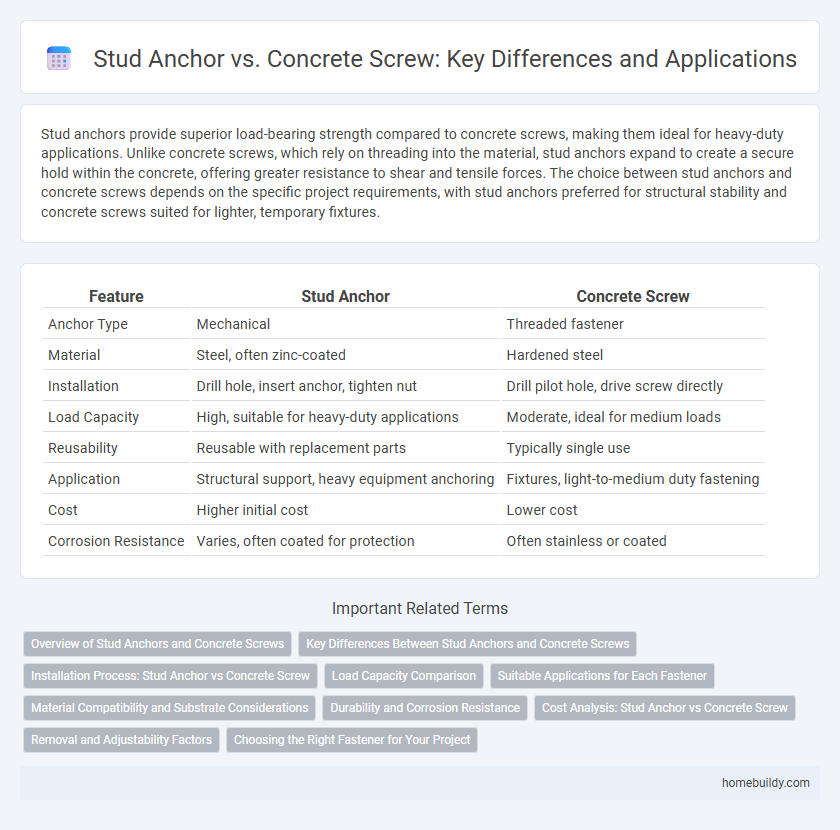Stud anchors provide superior load-bearing strength compared to concrete screws, making them ideal for heavy-duty applications. Unlike concrete screws, which rely on threading into the material, stud anchors expand to create a secure hold within the concrete, offering greater resistance to shear and tensile forces. The choice between stud anchors and concrete screws depends on the specific project requirements, with stud anchors preferred for structural stability and concrete screws suited for lighter, temporary fixtures.
Table of Comparison
| Feature | Stud Anchor | Concrete Screw |
|---|---|---|
| Anchor Type | Mechanical | Threaded fastener |
| Material | Steel, often zinc-coated | Hardened steel |
| Installation | Drill hole, insert anchor, tighten nut | Drill pilot hole, drive screw directly |
| Load Capacity | High, suitable for heavy-duty applications | Moderate, ideal for medium loads |
| Reusability | Reusable with replacement parts | Typically single use |
| Application | Structural support, heavy equipment anchoring | Fixtures, light-to-medium duty fastening |
| Cost | Higher initial cost | Lower cost |
| Corrosion Resistance | Varies, often coated for protection | Often stainless or coated |
Overview of Stud Anchors and Concrete Screws
Stud anchors are heavy-duty fasteners designed for high load-bearing applications in concrete, providing superior strength and durability through mechanical expansion or bonding with epoxy. Concrete screws offer a versatile and easy-to-install fastening solution for light to medium loads, featuring direct threading into pre-drilled holes without the need for expansion. While stud anchors excel in structural connections requiring maximum hold, concrete screws are preferred for quick, non-structural attachments with moderate load demands.
Key Differences Between Stud Anchors and Concrete Screws
Stud anchors provide high load-bearing capacity by expanding within drilled holes to create a secure hold in concrete, making them ideal for heavy-duty applications. Concrete screws, on the other hand, require pre-drilled holes and offer quicker installation with moderate load capacity suited for lighter fixtures. The key differences lie in their installation methods, load limits, and suitability for dynamic or heavy versus light to medium loads.
Installation Process: Stud Anchor vs Concrete Screw
Stud anchors require drilling a hole, inserting the anchor, and tightening the nut to create a strong mechanical bond in concrete, ensuring high load capacity and durability. Concrete screws are installed by drilling a pilot hole followed by directly driving the screw into the material, offering faster installation but typically lower load ratings. The stud anchor installation demands precise hole depth and cleaner holes for maximum embedment, while concrete screws accommodate quicker fixes with less surface preparation.
Load Capacity Comparison
Stud anchors provide significantly higher load capacity compared to concrete screws due to their deeper embedment and superior mechanical interlock within concrete substrates. While concrete screws are suitable for light to medium loads, stud anchors excel in heavy-duty applications, supporting greater tensile and shear forces. Engineers prefer stud anchors over concrete screws when maximum structural integrity and safety are critical in construction projects.
Suitable Applications for Each Fastener
Stud anchors are ideal for heavy-duty applications requiring high load capacity in solid materials such as concrete and masonry. Concrete screws are better suited for lighter loads and temporary fixtures, offering quick installation in thinner concrete slabs or existing drilled holes. Choosing between stud anchors and concrete screws depends on factors like load requirements, material thickness, and environmental conditions.
Material Compatibility and Substrate Considerations
Stud anchors provide superior material compatibility with a variety of substrates, including concrete, masonry, and steel, due to their robust design and corrosion-resistant materials such as stainless steel and carbon steel. Concrete screws, while effective in solid concrete, have limitations in hollow or cracked substrates and may not perform well in high-load applications or corrosive environments. Choosing stud anchors ensures reliable load distribution and greater adaptability across diverse substrate conditions, enhancing structural integrity and long-term durability.
Durability and Corrosion Resistance
Stud anchors offer superior durability compared to concrete screws due to their robust steel construction and deeper embedment, which enhances load-bearing capacity and resistance to mechanical stress. Their corrosion resistance is significantly improved when made from stainless steel or coated with zinc, providing long-term protection against rust in harsh environments. Concrete screws, while easier to install, typically have a lower corrosion resistance and may require additional coatings or treatments to prevent degradation over time.
Cost Analysis: Stud Anchor vs Concrete Screw
Stud anchors typically involve higher upfront costs due to material strength and installation equipment requirements compared to concrete screws, which are generally more affordable for light to medium-duty applications. While concrete screws offer quick installation and cost efficiency for non-structural loads, stud anchors provide superior load capacity and long-term durability, often justifying the initial investment in heavy-duty or safety-critical projects. Evaluating total project costs must consider not only material and labor expenses but also performance requirements and potential maintenance or replacement over time.
Removal and Adjustability Factors
Stud anchors offer superior removal and adjustability compared to concrete screws, as they can be unscrewed and repositioned without significant damage to the base material. Concrete screws often suffer from thread stripping or reduced holding power once removed, limiting their reusability and adjustment capabilities. The mechanical expansion design of stud anchors ensures reliable re-engagement in drilled holes, making them more versatile for applications requiring frequent adjustments or removals.
Choosing the Right Fastener for Your Project
Stud anchors provide superior load-bearing capacity and durability for heavy-duty applications, making them ideal for anchoring into concrete and masonry with minimal risk of pull-out. Concrete screws offer easier installation and removal with no pre-expansion required, suitable for lighter loads and temporary fixtures. Selecting the right fastener depends on project requirements such as load demands, installation time, and permanence, ensuring optimal performance and safety.
Stud anchor vs concrete screw Infographic

 homebuildy.com
homebuildy.com